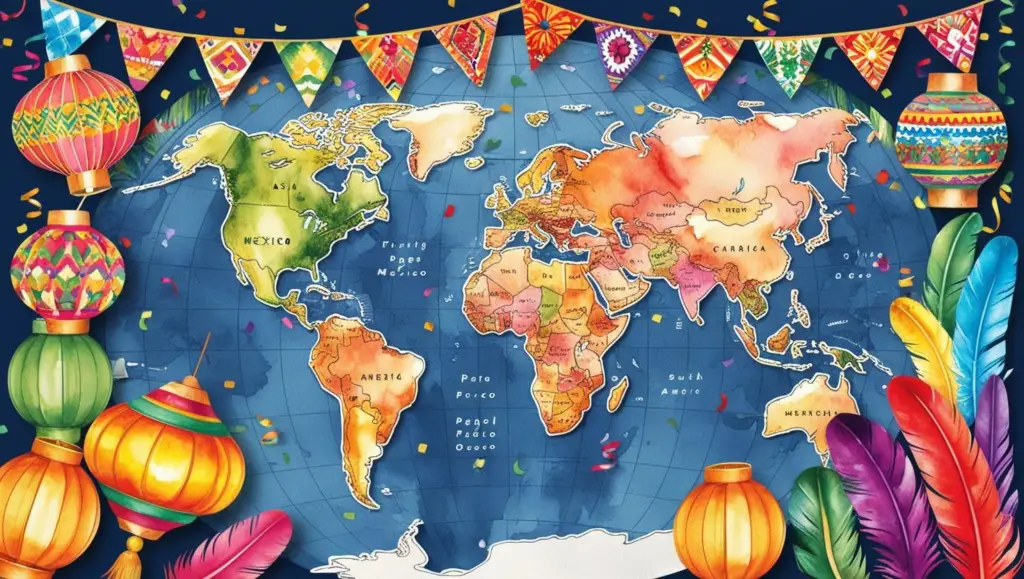From buttered noses in Canada to flying flags in Denmark, birthday celebrations around the world showcase humanity’s creative spirit in marking life’s milestones.
While blowing out candles might seem universal, different cultures have developed their own unique ways to honor another trip around the sun.
These diverse celebrations reveal how communities transform ordinary items – from flour in Jamaica to seaweed in Korea – into meaningful birthday rituals. Each tradition, whether it’s chair-lifting in Israel or sharing longevity noodles in China, tells a story about cultural values and the universal human desire to make birthdays memorable.
1. Canada’s Nose Greasing Tradition
In Atlantic Canada, birthday celebrations come with a unique twist – the birthday person gets their nose covered in butter or margarine. This peculiar butter noses tradition stems from an old belief that making the nose slippery prevents bad luck from sticking around during the coming year.
The practice shares similarities with Northern England’s birthday traditions, where families also butter the birthday person’s nose. Though somewhat messy, this charming ritual continues to bring smiles and laughter to birthday gatherings across the Canadian Atlantic provinces.
2. Jamaica’s ‘Antiquing’ with Flour
In Jamaica, birthday celebrations take a playful turn with the practice of “antiquing” – covering the birthday person in flour.
This messy tradition brings extra excitement to parties in Jamaica’s warm climate. Some celebrants combine the flour with other ingredients, similar to Brazil’s custom of adding eggs to the mix. While the birthday person might need a change of clothes afterward, the flour-throwing ritual creates memorable moments and lots of laughter among family and friends.
3. Mexico’s Piñata and ‘Las Mañanitas’ Song
Birthday celebrations in Mexico feature the classic piñata, filled with candies and small toys for children to break open. Las Mañanitas Mexican song, the traditional Mexican birthday song written in the 1950s, starts each celebration as family members gather to serenade the birthday person.
These cherished customs bring families together, with the piñata tradition spreading to birthday parties worldwide. The combination of music and the exciting piñata-breaking ritual makes Mexican birthday celebrations particularly festive and memorable.
4. India’s Cake-Feeding Custom
Birthday celebrations in India feature a heartwarming ritual where the birthday person hand-feeds pieces of cake to close friends and family members. This sweet gesture reflects the deep-rooted Indian cultural values of sharing food and showing care through personal attention.
The practice, common across different states from Maharashtra to Tamil Nadu, brings people physically closer during celebrations. Whether at home parties or last minute birthday gifts, this cake-feeding tradition strengthens bonds between loved ones and adds a personal touch to birthday festivities.
5. Israel’s Chair-Lifting Ritual
During Israeli birthday celebrations, friends and family members hoist the birthday person high on a chair, carrying them around the room while singing and dancing. This lively practice holds special meaning in Jewish festivities, representing the act of raising up and honoring the birthday person.
The tradition appears at various Jewish celebrations, from birthdays to weddings, with participants lifting the chair thirteen times for good luck. While common in Israel, this birthday custom also brings joy to Jewish communities worldwide, creating last minute birthday celebrations through physical connection and shared celebration.
6.Vietnam’s Collective Birthday Celebration on Tết
In Vietnam, birthdays traditionally merge with Tết, the Lunar New Year celebration, when everyone becomes one year older together. This cultural practice stems from traditional Vietnamese society, where individual birth dates held less significance than the communal New Year festivities.
During Tết, families gather to share special meals, exchange last minute birthday gifts, and mark their collective aging. While modern urban areas now often include personal birthday parties, many Vietnamese families maintain the age-old custom of celebrating birthdays during the Tết holiday season.
7. Ghana’s Fried Sweet Potato Patty Breakfast
In Ghana, birthday mornings start with the appetizing aroma of tatale, traditional fried sweet potato patties served as a special breakfast treat.
These golden-brown patties, made from mashed sweet potatoes mixed with local spices, offer a filling start to birthday celebrations. While similar to other cultures that mark birthdays with special morning meals, Ghana’s tatale tradition puts a distinctly West African spin on birthday breakfast customs, highlighting the country’s rich culinary heritage and use of native ingredients.
8. Australia’s Fairy Bread Treat
Australian children’s birthday parties feature a beloved snack called fairy bread – a simple creation of buttered white bread topped with colorful sprinkles.
This no-fuss party food has brought joy to generations of young Australians since the early 1900s. Parents arrange the triangular-cut pieces on party platters, making them a staple at last minute birthday celebrations across the country.
The treat’s staying power comes from its basic ingredients and the happiness it brings to children’s faces at countless birthday gatherings.
9. New Zealand’s Birthday Claps
Based on the available research, no specific information confirms the details or existence of a birthday clapping tradition in New Zealand.
While many countries have distinct birthday customs that mark age milestones through physical gestures or activities, the practice of birthday claps in New Zealand requires additional verification. Other birthday celebrations in New Zealand often follow patterns similar to those in other English-speaking countries, including cake-cutting, singing, and last minute birthday celebrations.
10. Denmark’s Flag-Flying and Bed-Surrounding Gifts
Danish birthday celebrations feature two distinctive customs that make the day extra special. On birthdays, families proudly display the Dannebrog (Danish flag) outside their homes, marking the occasion with national pride.
The morning begins with a heartwarming surprise as the birthday person wakes to find presents carefully arranged around their bed. Family members quietly place last minute birthday gifts during the early hours, creating a circle of presents that greets the birthday person upon waking. This combination of patriotic display and thoughtful gift-giving reflects Denmark’s strong family values and cultural identity.
11. The Netherlands’ ‘Gefeliciteerd’ Greeting and Cheek Kisses
Birthday celebrations in the Netherlands bring families and friends together through distinct social customs. When guests arrive, they greet the birthday person with “Gefeliciteerd” (congratulations) followed by three friendly kisses on the cheeks.
The celebration extends beyond immediate family, as Dutch birthday parties often include extended relatives and close friends. Guests typically sit in a circle, sharing coffee, cake, and conversation while following these time-honored greeting practices that strengthen social bonds in Dutch culture.
12. Egypt’s ‘Hafla’ Celebration with Flowers and Fruit
In Egypt, birthday parties center around the ‘hafla,’ a festive gathering that brings family and friends together. While specific details about flower and fruit traditions during birthday celebrations remain limited in historical records, modern Egyptian birthday parties often include seasonal fruits and floral arrangements as decorative elements.
These social gatherings reflect Egypt’s emphasis on community celebration, with guests sharing meals and spending time together to mark the special occasion. Middle Eastern birthday customs commonly feature fresh fruit platters and sweet treats, making food a central part of the festivities.
13. China’s Longevity Noodles and Peach-Shaped Buns
Chinese birthday celebrations feature two meaningful food traditions that carry wishes for a long life. The birthday person eats extra-long noodles in a single strand, as cutting them might shorten one’s lifespan according to cultural beliefs.
Along with noodles, peach-shaped buns called “shoutao” appear at birthday tables, representing health and immortality in Chinese culture. This combination of special birthday foods appears at celebrations across China, from family gatherings in Beijing to festivities in rural villages, connecting modern parties to ancient customs.
14. Sweden’s Birthday Breakfast in Bed
Based on the available information, there are no confirmed details about a specific breakfast-in-bed birthday tradition in Sweden. While many Swedish families mark birthdays with special meals and gatherings, the practice of serving breakfast in bed requires additional verification.
Swedish birthday celebrations typically include other customs like cake, songs, and family get-togethers, similar to those found in other Scandinavian countries. Local birthday parties often feature traditional Swedish pastries and treats during last minute birthday celebrations.
15. Korea’s Seaweed Soup Tradition
Korean birthdays start with a steaming bowl of seaweed soup, known as miyeok-guk. This tradition links back to mothers who eat seaweed soup after giving birth, making it a symbol of maternal care and life’s beginnings.
The nutritious soup appears at breakfast tables across South Korea on birthdays, connecting people to their birth stories and family bonds.
Whether served in modern Seoul apartments or small village homes, the comforting soup carries on as a birthday must-have, reminding Koreans of their mothers’ love and cultural heritage.
16. Poland’s Name Day Celebrations
In Poland, many people mark two special occasions each year – their birthday and their Name Day (imieniny). Name Days follow the Catholic calendar of saints, with each day honoring specific saints and their associated names.
When someone’s name matches a saint’s day, friends and family gather to share last minute birthday gifts, sweets, and drinks.
The festivities often include coffee, cake, and well-wishes, making Name Days as important as birthdays in Polish culture. Some Poles prefer celebrating their Name Day over their birthday, particularly in traditional communities where this custom maintains strong roots.
17. Japan’s Red and White Rice and Beans Dish (Sekihan)
Japanese birthday tables feature sekihan, a special dish of red rice cooked with azuki beans. This bright red and white combination holds deep meaning in Japanese culture, marking joyful occasions beyond birthdays.
Families serve sekihan at milestone events like graduations, weddings, and New Year celebrations.
The red color, coming from the beans, represents happiness and good fortune in Japanese traditions.
Whether homemade or store-bought, this festive dish remains central to birthday meals across Japan, connecting modern celebrations to centuries-old customs of last minute birthday celebrations.
Celebrating Life Across Cultures
These birthday traditions from around the world demonstrate how different cultures transform simple elements – food, gestures, and communal activities – into meaningful celebrations.
From Vietnam’s collective age advancement during Tết to Australia’s beloved fairy bread, each custom reflects deep-rooted cultural values and social bonds.
While these traditions may seem worlds apart, they share a common thread: the universal human desire to mark life’s milestones with joy, community, and meaningful rituals.
Whether it’s through buttered noses, chair-lifting, or special meals, these celebrations remind us that birthdays are about more than just counting years – they’re about strengthening connections and creating lasting memories.


